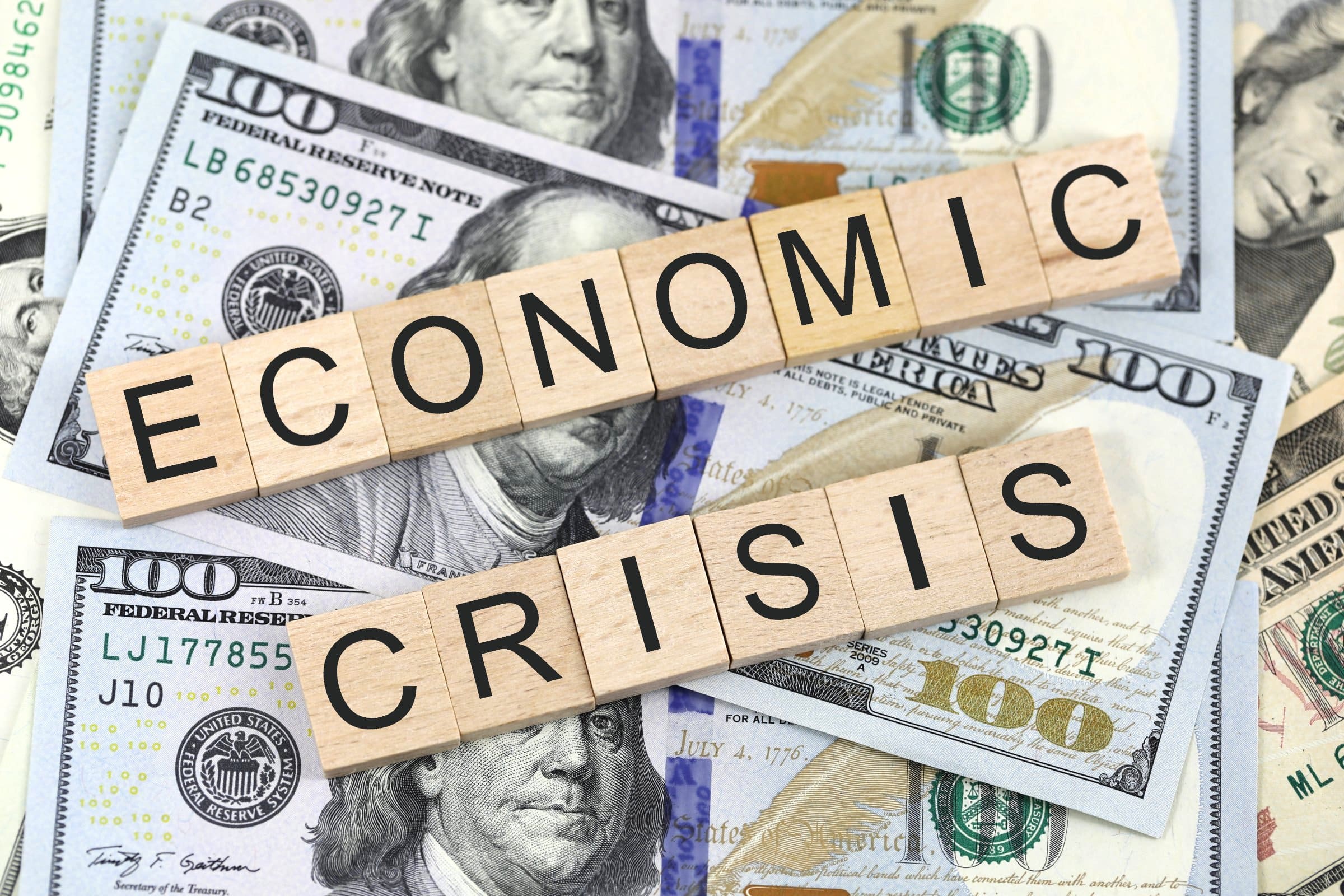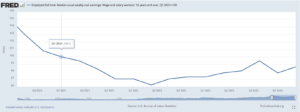Official propaganda is trumpeting that the Federal Reserve Bank is pulling off a soft landing for the economy after the excesses of the COVID deficit/inflationary era. For example, CNN circulated a story on July 25 boasting that: “America’s economy is about to stick what’s called a ‘soft landing,’ which is when inflation returns to the Fed’s target without a recession — a feat that’s only happened once, during the 1990s, according to some economists.”
But is the Fed sticking the landing or just giving the country the shaft?
First, the good news: the Federal Reserve Bank has in the last couple years pulled back $1 trillion in money (M2) from the $4 trillion it created in new money during 2020-21. It also shed $1.8 trillion from its bloated balance sheet, down to $7.2 trillion. Moreover, interest rates aren’t zero and nominally the Federal Funds Discount Rate for banks has risen to more than five percent.
So, on the surface, it looks like the Federal Reserve Bank is being fiscally responsible in the fight against inflation without tanking the economy.
But there’s a whole lot of bad news as well. First, interest rates remain too low, with real interest rates (after accounting for the CPI inflation) still at two percent, and most economists are expecting two rate cuts this year. Additionally, because it’s an election year, and the Fed —at least since the year 2000— typically eases interest rates in election years to appease incumbents, that’s probably what will happen. Also federal deficit spending is out of control, with congressional spending to create an expected $1.99 trillion deficit in the fiscal year 2024 that ends on September 30, a deficit projected to increase annually into the indefinite future. And deficits are ballooning in part because the rise in interest rates has increased the amount of the federal budget being paid toward servicing the national debt, passing the $1 trillion mark.
Debt-to-GDP
Most economists reasonably agree that a key danger to the economy is the level of debt as a proportion of Gross Domestic Product (GDP). Right now, US federal debt is nearing the 125% of GDP level and increasing by two or three percent annually. The metric is based upon the common sense idea that you can only manage debt in line with your income.
Ironically, if the only metric is debt-to-GDP, then the federal government could run trillion-dollar deficits forever and never increase that ratio in our $28 trillion economy. If the economy grows just two percent per year in real terms and inflation is three percent per year, then the federal government could pile on $1.4 trillion in new debt (5% of $28 trillion) forever and never increase the debt-to-GDP ratio. In fact, the debt-to-GDP ratio fell in 2022 with a $1.4 trillion deficit because of an 8.0% CPI inflation rate.
The federal government could only run trillion dollar deficits forever in theory, however.
And in a macabre kind of way it’s impressive that Japan has managed to build up a debt-to-GDP ratio of 255%, more than twice the ratio of the United States.
In some sense, Japan should be the canary-in-the-coal-mine for a US debt collapse if debt-to-GDP is the sole marker for collapse. Japan doesn’t even have the luxury of its Yen being the world’s reserve currency. But because Japan’s national debt is denominated in Yen, one can make the distinction between Japan and the collapse of Greece when its debt-to-GDP ratio hit 150% in 2010: Greece’s debt was denominated in Euro, a currency Greece couldn’t control or inflate. In Japan’s case, the Bank of Japan just floated the debt and bought it up, accumulating more than half of Japan’s national debt onto its balance sheet since the 1990s. And there’s no end in sight, despite a pretense in its recent reports at austerity.
Japan has already paid a heavy price for its fiscal recklessness. Sure, the market price of Japanese debt is artificially propped up to the highest level among the G8 nations (thus earning the lowest rate of interest among developed G8 nations). So the cost of servicing its national debt has remained low. But Japan’s credit rating has fallen from AAA in the 1990s to A today, just two notches above junk bond status. More importantly, for decades, its economic growth has been flat even after accounting for a collapsing population. However, the house of cards the Bank of Japan has erected for the Japanese economy hasn’t fallen down yet.
It’s unlikely the US would be able to build up to greater than a 255% debt-to-GDP ratio, like Japan has, before a collapse. For one, the coming collapse of the Japanese economy will be a dire lesson for the global economy that would soon impact the US and Italy, both of which are trending in Japan’s direction.
There’s another key metric for the debt that’s probably more important right now, and that’s the ability of markets to float deficits and new debt being created by Congress. Of course, it’s natural that the Fed should have been able to raise interest rates in 2022-23 by raising its discount rate to over five percent and selling off $1.7 trillion in US Treasuries into the open market. The move let US Treasuries fall to the weakest issue among the developed nations in the G8, increasing yields on 10-year T-bills well over four percent.
In order to accomplish two rate cuts this year that are more than paper reductions, the Fed will need to undo what it’s done since 2022 with both interest rate increases and balance sheet sell-off. And that means the Fed will have to start building up its balance sheet again and follow the path Japan has already trod.
The flood of new federal debt at that rate of $2 trillion annually is bound to weaken US debt in international markets (thus demanding higher interest rate yields) without strong Federal Reserve intervention.
The Fed’s options are to (1) re-inflate its balance sheet by buying more federal debt, (2) spike inflation by digitally printing the difference, or (3) let interest rates soar at market rates and create a federal budget crisis as well as a serious recession. The latter two are politically unacceptable, so the Fed is likely to go with option #1. Suppressing interest rates will also help with the cost of financing federal debt, at least in the medium term.
But even option #1, blowing the balance sheet back up and suppressing interest rates further, will have the same serious short-term consequences Japan is already experiencing: Low-to-no economic growth from malinvestment and perpetually lowered credit ratings for the federal government.
Democrats’ impossible hurdle: The struggling middle class
That means we’re not likely headed imminently into a drastic economic crash, but neither are we headed for a “soft landing,” at least not a landing soft enough to save the Democrats at the polls in November.
For middle class American families, it already hasn’t been a soft landing. Real median family income and real median wages have both fallen sharply during the Biden presidency, which is why the Biden/Harris propaganda machine ineffectively tried to convince Americans they’ve never had it better despite a year-long propaganda overdrive. And while there’s been some improvement among middle class wages since the second quarter of 2022, it hasn’t been enough to make up the losses since inauguration day. Average Americans are still earning 1.3% less (about $775) less per year in 2024 in real terms than they were in 2021.
It’s shocking to me that opponents of the Democrats (not just the Republicans, but the Libertarians, Robert F. Kennedy Jr., and the Green Party as well) aren’t putting this chart in neon:
While real per capita GDP has increased 7.7% since Biden was inaugurated, why is it that the real median (i.e., the 50th percentile, so the middle-est of the middle class) wage has decreased 1.3%?
This is not a result of natural free market forces, though it’s astonishing the economic left isn’t doing its worst to pummel the Biden/Harris administration. Free market economists know below market interest rates tend to help those with the credit to borrow, which tends to help the wealthiest in society. Federal Reserve policies are creating a plutocracy by design that either Libertarians, Republicans or the left will eventually pick up on as an election theme to achieve political victory.
The unassailable political fact is that if the rich are getting all the gains in the economy, and the middle class and the poor are falling further behind, then the latter have more votes in November. Economics is complex, but I can understand how the economy works. What I can’t understand is how dumb the Libertarians, Greens, Republicans and RFK2 have been during this campaign in not wielding their political cudgel against the Federal Reserve Bank.

































